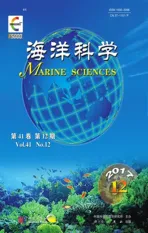苏北浅滩外侧潮汐锋的季节变化及结构分析
2017-05-04程雪丽王玉衡
程雪丽, 孙 群, 王玉衡, 杨 洋
苏北浅滩外侧潮汐锋的季节变化及结构分析
程雪丽, 孙 群, 王玉衡, 杨 洋
(天津科技大学 海洋与环境学院, 天津 300457)
利用高分辨率(1/18°)的POM(Princeton Ocean Model)模式数值模拟结果, 结合观测数据分析了苏北浅滩外侧潮汐锋的季节分布特征和变化规律。研究结果表明, 苏北浅滩外侧潮汐锋的季节变化特征显著, 春末开始出现, 夏季底层温度锋强度最大且锋区位置较稳定, 锋区宽度约40 km, 平均强度约0.35℃/km, 秋、冬季随上层海洋湍流垂向混合的加强, 潮汐锋逐渐减弱至消失不见。对比实测数据和模拟结果发现, 沿34°N断面, 夏季潮汐锋区附近等温线明显抬升, 存在由陡峭地形和分层流体的内埃克曼效应共同作用形成的上升流现象。次表层海水出现低温冷水区, 位于122.2°E附近。跨锋区断面的温度和流场分布特征同浅水区强烈的潮混合过程密切相关, 斜压在锋面处产生了较强的南向流动。本研究结果促进了对苏北浅滩外侧陆架潮汐锋结构特征的认识, 为研究黄海西部生态环境的动力过程影响提供参考。
苏北浅滩; 潮汐锋; 潮汐锋季节变化; 上升流
陆架潮汐锋是在潮致混合和夏季层化共同作用下, 于近岸垂向混合均匀水体与外海层化水体之间形成的过渡区[1-2]。锋区的物理、化学和生物环境参数存在显著的水平梯度变化, 其动力结构也比较复杂。已有研究表明, 陆架潮汐锋是主要的上升流区[3-5]。此外, 沿锋区存在较强的射流[3], 由此引起的水平压强梯度力驱动跨锋流[6-8]。
南黄海的苏北浅滩外侧属于浅海强潮区, 在由春入夏的增温季节会形成显著的潮汐锋现象, 具有明显的季节变化特征[2, 9], 由水平和垂向速度剪切引起的上升运动是影响温度结构分布的主要因素, 存在跨锋面的低盐水向温跃层的入侵[10]。同时, 锋区附近海域生物、化学量的分布特征也间接证明了锋区动力过程的复杂性, 形成独特的锋区生态环境场。南黄海西部潮汐锋是影响鳀鱼产卵场的关键物理过程之一, 潮汐锋区的环流辐聚、辐散是形成潮汐锋区鳀鱼卵子和稚仔鱼斑块分布的原因[11-12], 此外, 锋面外侧也是中华哲水蚤垂直分布的中心区域[13]。针对苏北浅滩外侧潮汐锋区构成的海洋生态特殊环境场, 韦钦胜等[14]提出了锋区生态系统的观点。
潮汐锋在时空尺度上属于中尺度运动, 以往基于现场观测资料的分析有其局限性, 不能很好地刻画锋区的时、空结构。本文采用(1/18)°的高分辨率数值模拟, 考虑底边界层潮致混合的影响, 探讨苏北浅滩外侧潮汐锋动力结构的季节变化分布。
1 资料和方法
本文采用Guo等[15]和Wang等[16]发展的东中国海三层嵌套的高分辨率POM(Princeton Ocean Model)模式数值模拟结果, 图1给出POM模式的数值模拟海域和苏北浅滩研究海域, 空间范围为32.5°~35.5°N, 119°~125°E。POM模式的水平空间分辨率为(1/18)°, 垂向分为21层, 近海表处采用对数分层, 划分的空间网格更细。模式的海表驱动场采用气候态月平均的风应力、净热通量和淡水通量等再分析数据, 资料来自NCEP/NCAR再分析数据(http: //www.esrl.noaa. gov/psd/data/gridded/data.ncep.reanalysis.surfaceflux.html)。Wang等[16]在POM模式中考虑东中国海潮汐及河流径流的影响, 利用该数值模拟结果探讨了渤海黄河羽状锋的季节变化特征及其机制。我们利用国家海洋局提供的1964—1999年常规断面温度观测资料[17], 通过进行多年逐月平均, 得到观测数据的气候态月平均温度数据, 并与数值模拟结果进行了相关性分析, 两者间相关系数为0.86。
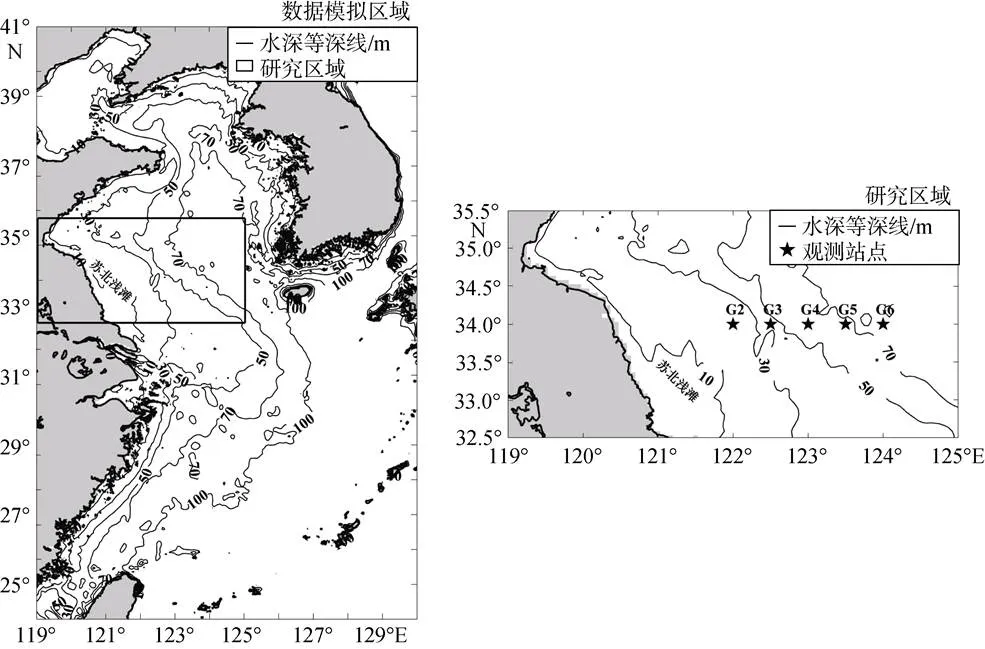
图1 研究海域地形分布
图2给出34°N断面8月份的温度垂向结构分布, 该断面跨越苏北外海的陆架锋, 对研究跨锋水文结构变化具有代表性。观测数据采用国家“973”计划“中国近海水母暴发的关键过程、机理及生态环境效应”项目于2013年8月27日利用SeaBird CTD在该断面的温度实测数据, 观测站位见图1研究海域(G2—G6)。由于夏季较强的海表太阳辐射作用, 在浅滩外海(123.0°E以东)15 m深处出现强层化现象, 形成温跃层, 表层水温28℃, 温跃层以深存在一结构稳定的低温冷水团。由于地形变浅, 在122.5°E西侧20 m处等温线向上抬升, 在锋区附近的次表层形成低温区, 下层等温线下弯, 与海底相交, 在底层形成很强的水平温度梯度, 即底层温度锋所在位置。通过比较, 数值模拟的温跃层位置较观测结果要浅, 这可能是由于模式在夏季上层混合偏弱所致[18-19]。
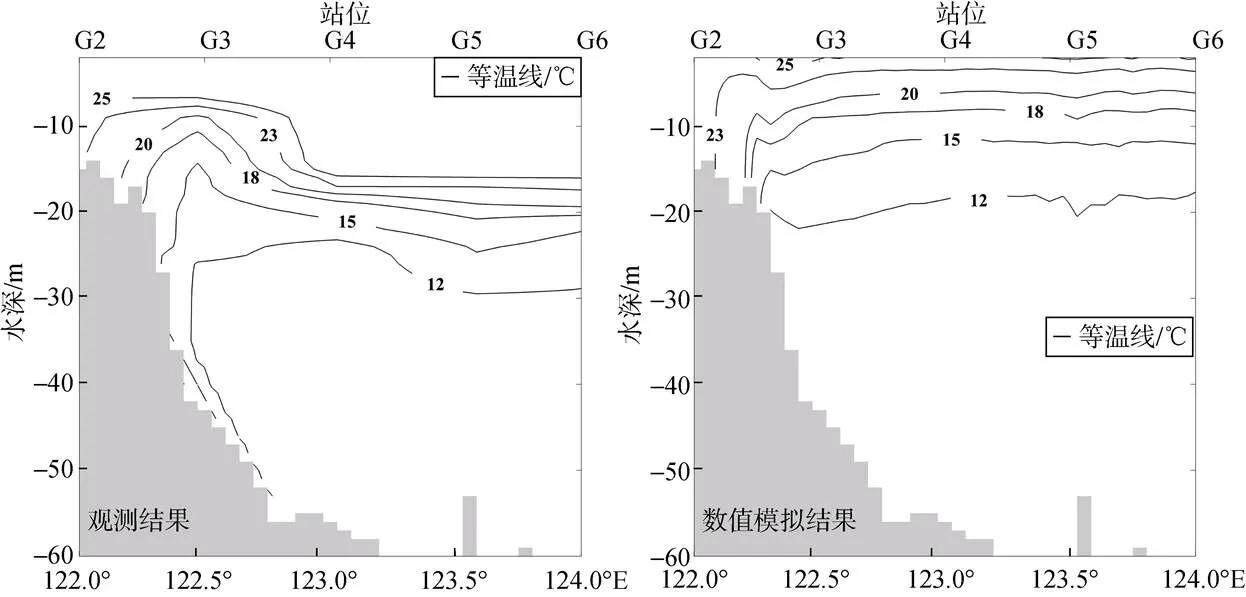
图2 沿34°N断面的温度分布

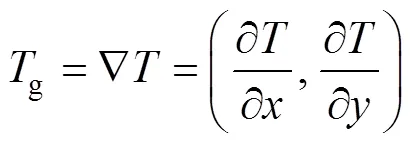
沿锋面温度梯度的方向角可表示为:

由于苏北浅滩外海潮汐锋出现在春末夏初上层海洋增温季节, 表层温度梯度减弱, 故此处对不同深度采用温度梯度法, 以更好地确定潮汐锋的位置和强弱。根据已有研究结果[20-21], 取水平温度梯度大于0.03℃/km作为判别锋点的标准, 而锋点上垂直于梯度的方向为沿锋方向。
2 结果分析与讨论
2.1 潮汐锋结构特征和季节演变
锋区位置与表示潮混合强烈程度的Simpson- Hunter层化参数SH有关。Simpson和Hunter[22]基于局地能量平衡分析, 指出潮致混合所需能量与层化势能需达到局地平衡, 给出SH的临界值。已有研究表明[23-24]锋区平均位置与临界值所处海域较一致。SH表示为:

其中,代表潮流特征流速,为水深, 该参数反映了潮流和地形的共同影响。
苏北浅滩外海是典型的半日潮海域[25-26],SH中的潮流特征流速取为平均最大潮流流速[1]。利用潮汐预报软件OTPS(OSU Tidal Prediction Software)[27-28]计算M2, S2, O1和K14个主要分潮的调和常数, 平均最大潮流流速可由4个主要分潮流速的东、北分量及其频率和振幅迟角计算得到。图3a给出研究海域M2分潮同潮时线和最大潮流的模拟结果, 图3b为SH的分布。在黄海近岸浅水区(水深在30 m以浅), 强烈的潮致垂向混合导致近岸浅水区温度结构趋于垂向均匀分布, 而外海潮混合较弱, 且因季节增温出现层化现象, 导致在两种水文特征显著不同的区域之间出现一个过渡带, 形成明显的潮汐锋现象。除本文关注的苏北浅滩潮汐锋区外, 由图3b可知, 在山东半岛成山角-石岛近海、苏北沿岸和朝鲜半岛西岸等沿岸浅水区也均出现潮汐锋[2, 4]。
苏北近海的潮汐锋常出现在苏北浅滩外侧的陡坡附近。赵保仁等[4]观测结果表明, 苏北浅滩外侧潮汐锋现象与该海域地形特征关系十分密切。图4给出根据公式(1)和(2)得到的苏北浅滩外侧潮汐锋的季节变化分布。潮汐锋矢量图中箭头长度表示锋的强度(即梯度大小), 方向表示锋的走向, 相邻多个锋点形成锋区。由于受海表流场及风场等影响, 表层锋较弱且很不稳定, 所以图4中给出对应底层水温分布及底层锋结构的季节变化。选取5、8、11、2月份作为春、夏、秋、冬季4个季节的代表月。
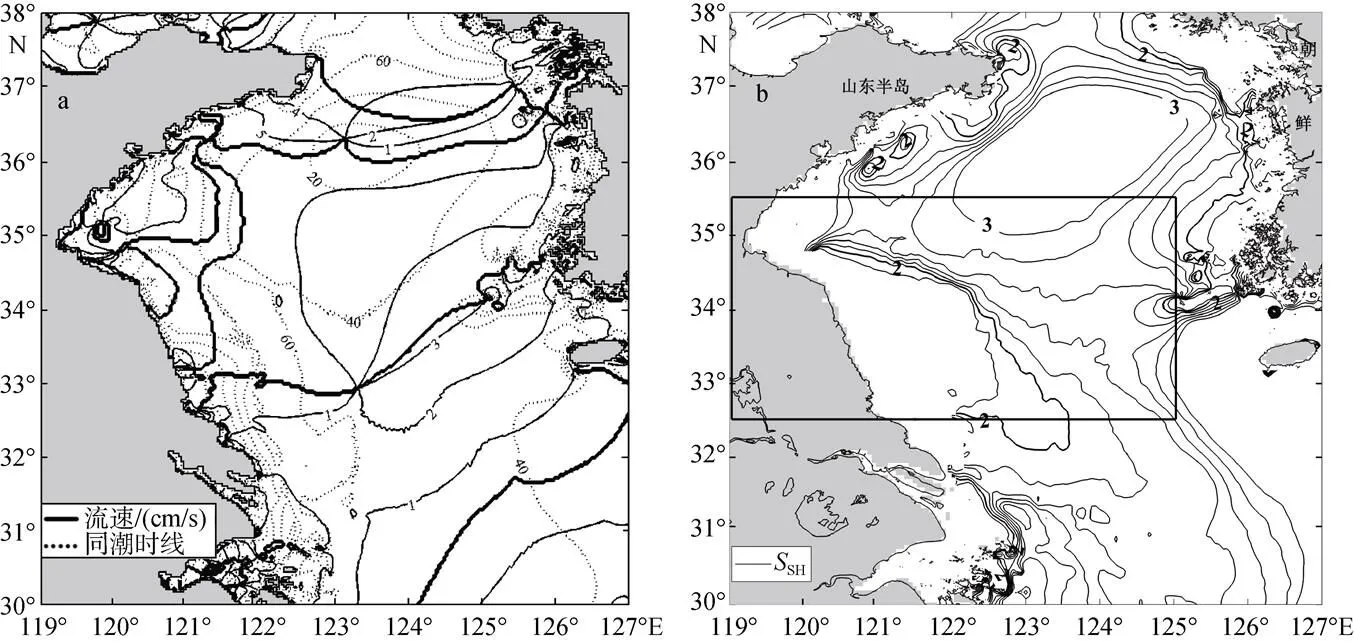
图3 研究海域潮汐和层化特征分布
a. 模拟M2分潮最大潮流; b.SH
a. Biggest flow of simulated M2; b.SH

图4 苏北浅滩底层温度锋的季节变化
春季, 随着海水温度逐渐升高, 底层温度表现为近岸浅水区高, 外海深水区低的格局。到了5月, 由于近岸潮致垂向混合强烈, 导致苏北浅滩海域与其外侧海域之间的温度梯度逐渐增加, 沿20~30 m等深线开始出现温度锋, 但温度锋强度较弱, 约为0.14℃/km, 宽度约为28.84 km。
夏季, 底层温度锋区位置水平温度梯度变化剧烈, 以30 m等深线为界, 东西两侧的温度分布迥然不同, 西侧浅水区为充分混合区, 水温呈垂直均匀分布状态, 整个浅滩上海水温度均约28℃, 达到全年最高; 东侧为层化区, 由于黄海冷水团的存在, 在30 m以深海域水温较低, 水温为10℃。沿苏北浅滩外侧形成一西北-东南向的温度锋区, 由于表层受太阳辐射影响, 海表温度整体较高, 故夏季潮汐锋区的海表温度梯度变化并不显著, 而由于潮汐锋区上升流[4, 23, 29]的影响, 导致在锋区附近次表层出现一低温冷水区(如图5), 冷水区位于122°~123°E, 水温小于25℃, 比周围水体温度低1~2℃, 该低温中心是由于锋区上升流所致。
夏季, 苏北浅滩海域风应力较弱, 风生湍流垂向混合影响的深度较浅, 上混合层厚度只有5 m[23, 30]。同时, 通过海面向海洋输入的净热通量较大, 在苏北浅滩外海出现显著层化, 而在近岸浅水区(20 m以浅), 潮致底边界层的强烈湍流混合破坏了这种层化结构, 使得浅水区在夏季依然保持由表至底的温度垂向均匀分布, 如图6中夏季的温度分布。由于近岸浅水区上层暖水与下层冷水之间的充分混合, 致使整个深度范围内混合均匀后海水温度低于外海表层水温, 而高于层化区下的底层水温。因此, 等温线分布表现为上层等温线上翘, 下层等温线下弯(如图6), 这种台状结构是由潮混合控制[1]。苏北浅滩外侧潮混合发达的近岸浅水区和外海层化区之间存在较大的水平温度梯度, 形成了显著的潮汐锋。潮汐锋的平均强度为0.35℃/km, 水平宽度可达40 km, 8月其形态及强度都发展到最大。
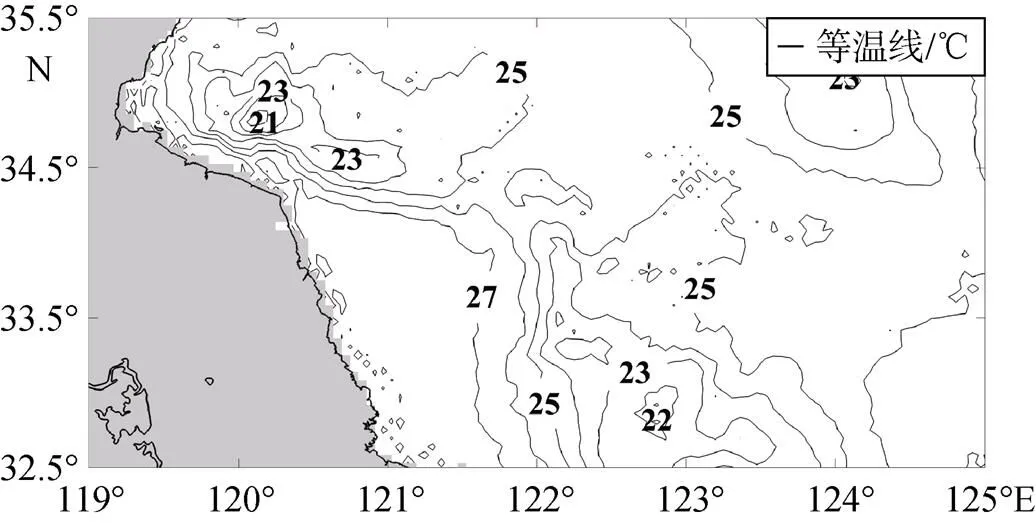
图5 夏季2 m层温度的水平分布
秋季随着海表气温的降低, 海水温度下降, 近岸浅水区温度减小幅度相对要快, 水平温度梯度减小, 潮汐锋强度减弱。冬季随着大风降温过程, 湍流垂向混合强烈, 可直达海底, 形成表、底层水温均匀分布状态, 最低水温出现在冬季。等温线基本沿岸线分布, 呈西北东南走向。苏北浅滩外测的温度锋减弱消失。
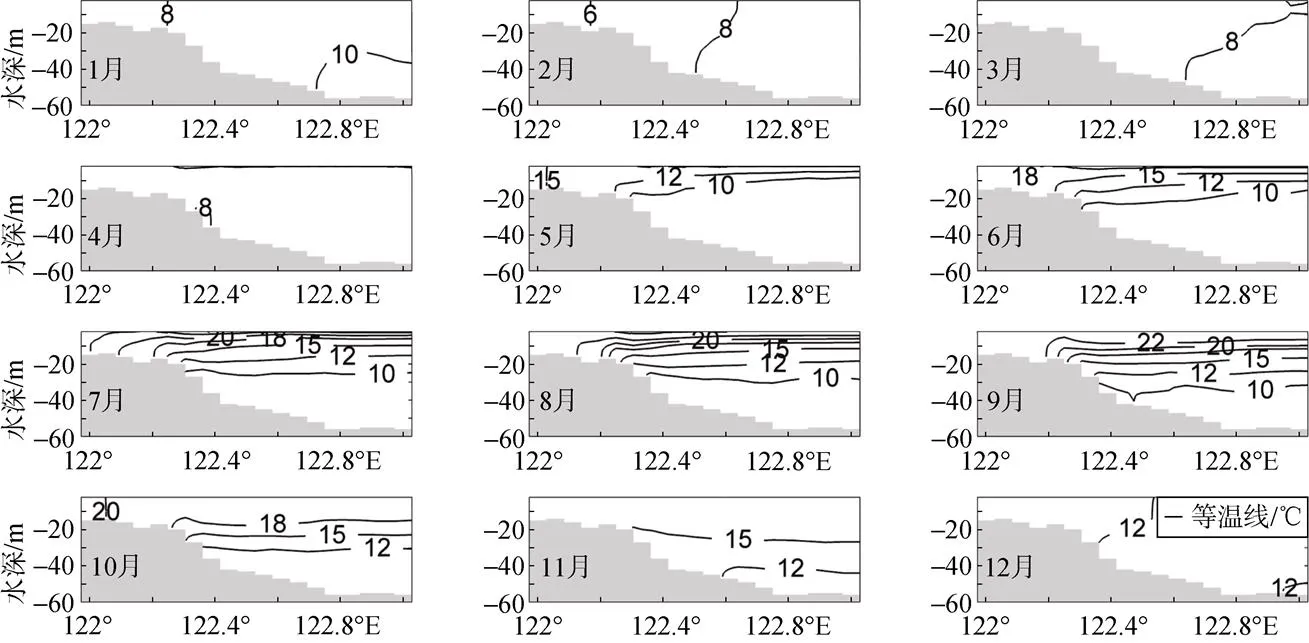
图6 34°N断面温度分布
2.2 跨锋区的温度变化特征
选取34°N断面的温度结构分析了潮汐锋的季节变化特点(图6)。5月黄海的层化现象已初步形成, 6—8月层化进入强盛期, 从9月开始逐渐减弱。与层化现象相联系的潮生陆架锋和近表层冷水分布一般于5月已显雏形, 6—8月进入强盛期, 9月因海面降温而逐渐减弱, 10月海面已很难辨认出潮汐锋的存在[31]。
夏季, 以122.2°E为界, 以西海底比较平坦, 水深较浅16~20 m, 为温度垂直均匀区; 以东海底坡度陡增, 在123°E处水深达60 m, 为显著层化区。122.2°E东侧等温线有明显的抬升现象。等温线的这种抬升现象表现为122°~122.5°E附近表层出现低温冷水区, 水深在10 m处温度为20℃左右, 比周围水体温度低1~2℃, 该冷水区表层最低水温为24.4℃。在该冷水区附近形成较显著的温度锋面, 显然这是潮汐锋的位置。
2.3 潮汐锋区的流场结构特征
夏季黄海近海面的温度锋与底层温度锋是同时存在的, 在近海面温度锋的下方可以看到等温线密集的海底锋区。赵保仁[3]曾使用温盐资料指出沿黄海陆架锋与冷水团边界是黄海锋面上升流区, 南黄海西部沿岸流是沿锋面南下的强流。
图7给出34°N断面流速东分量、北分量、垂向流速的分布。在34°N断面陡坡处流速较大, 上层向岸, 底层离岸。在陡坡122.2°E附近, 上层离岸, 底层向岸。因此, 在陆架陡坡处产生了沿坡向上的上升流作为补偿。
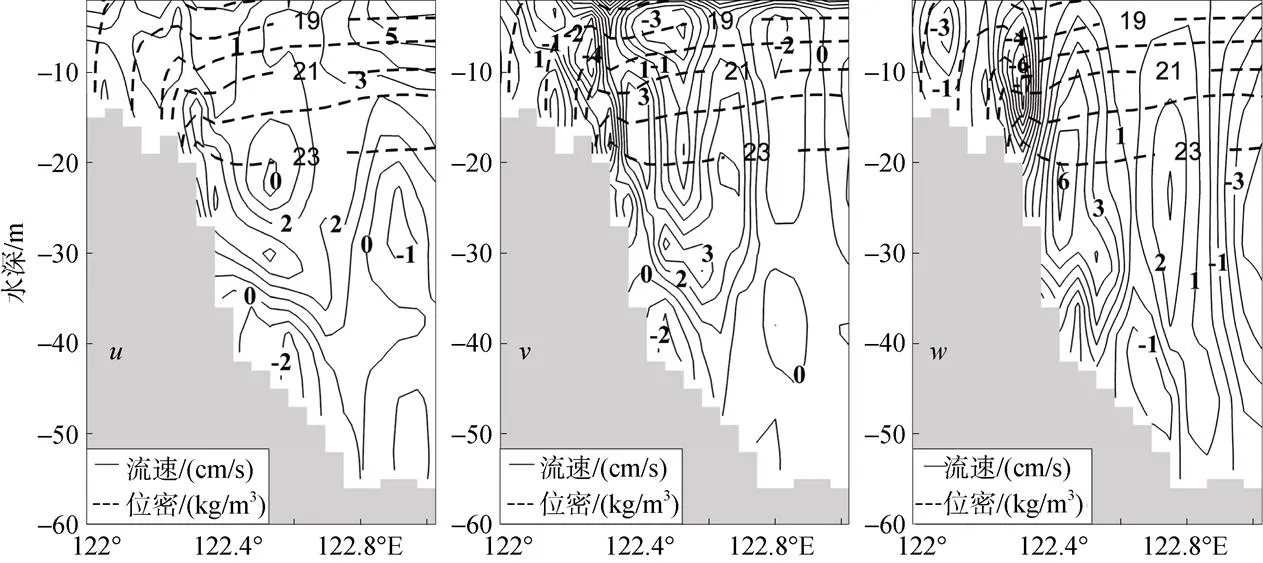
图7 34°N断面流速分量分布
在陆架上沿锋存在一支南下的强流(为负值),最大流速达4.48 cm/s, 其两侧为反向回流, 量值较小。Brown等[5]在北海潮汐锋冷水区边缘, 沿锋面方向观测到较强射流的存在, 最大流速可达15 cm/s。因较小, 图7中垂向流速为乘以权重放大后的结果, 令(其中1 000 m为水平特征尺度,为水深)得到的分布图, 在陆架的陡坡处为上升流区, 最大值达6×10–3cm/s, 其外侧为同量级的下降流区。
锋区上升流的出现一方面是由于斜压在锋面处产生较强的南向流动, 且在分层流体的分层界面存在内摩擦。由于内埃克曼效应, 向南的速度分量在分层界面以上产生离岸的通量, 在其下则产生向岸通量。上层较强的离岸通量将在122.2°E附近陆坡处产生上升流作为补偿。同样, 在122.2°E附近向北的沿锋流诱导出向岸的上层流, 因此在122°~122.5°E 产生了较强的辐聚区。另一方面, 海底陡坡使补偿流限制在较小的范围内从而增大了上升流速。
3 结论
根据Simposon-Hunter提出的潮混合形成浅水陆架锋的概念, 温度锋的位置可以用层化参数SH来确定。研究表明苏北浅滩外侧表层以下存在着显著的温度锋, 且具有明显的季节变化特征, 春季苏北浅滩外侧开始出现温度锋, 到了夏季该温度锋达到最强且位置稳定, 温度锋宽度达40 km, 平均强度0.35℃/km。秋冬季随着海面降温该温度锋逐渐减弱消失。
典型跨锋区断面(34°N)的温度分布具有显著特征, 122.2°E以西的陆架浅水区为垂直均匀区, 表、底层之间的温度差约为1℃, 122.2°E以东外海区为层化区。在底层强温度锋东侧(122.2°E 以东), 等温线有抬升现象, 出现上升流, 在次表层形成低温区。锋区流场分布给出苏北浅滩陆架潮汐锋与冷水团边界是黄海锋面上升流区, 南黄海西部沿岸流是沿锋面南下的强流。跨锋区断面的温度和流场分布特征同浅水区强烈的潮混合过程密切相关, 潮致湍流垂向混合是影响苏北浅滩外侧锋面强弱的重要动力因素。
[1] 赵保仁. 黄海冷水团锋面与潮混合[J]. 海洋与湖沼, 1985, 10(6): 451-559.
Zhao Baoren. The fronts of Yellow Sea cold water mass induced by tidal mixing[J]. Oceanologia et Limnologia Sinica, 1985, 10(6): 451-559.
[2] 赵保仁. 黄海潮生陆架锋的分布[J]. 黄渤海海洋, 1987, 5(2): 16-25.
Zhao Baoren.The continental shelf fronts induced by tidal mixing in the Yellow Sea[J]. Journal of Oceannography of Yellow Sea and Bohai Sea, 1987, 5(2): 16-25.
[3] 赵保仁. 南黄海西部的陆架锋及冷水团锋区环流结构的初步研究[J]. 海洋与湖沼, 1987, 18(3): 217-227.
Zhao Baoren. A preliminary study of continental shelf fronts in the western part of southern Yellow Sea and circulation structure in the front region of the Yellow Sea Cold Water Mass(HCWM)[J]. Oceanologia et Limnologia Sinica, 1987, 18(3): 217-227.
[4] 赵保仁, 涂登志, 毕亚文. 苏北浅滩外侧浅水锋的观测与分析[C]//中国科学院海洋研究所. 海洋科学集刊(34). 北京: 科学出版社, 1993: 51-60.
Zhao Baoren, Tu Dengzhi, Bi Yawen. Observations and analyses of the shallow water front in the outside of the SuBei Shoal[C]// Institute of Oceanology, Chinese Academy of Sciences. Studia Marina Sinica (34). Beijing: Science Press, 1993: 51-60.
[5] Brown J, Hill A E, Fernand L, et al. Observations of a seasonal Jet-like circulation at the central North Sea Cold Pool Margin[J]. Estuarine Coastal and Shelf Science, 1999, 48(3): 343-355.
[6] Yanagi T, Ishikawa K, Inoue K I, et al. Convergence, divergence and vertical velocity at a tidal front in Hiuchi-Nada, Japan[J]. Journal of Oceanography, 1995, 51(2): 225-238.
[7] Farmer D M, D’Asaro E A, Trevorrow M V, et al. Three-dimensional structure in a tidal convergence front[J]. Continental Shelf Research, 1995, 15(13): 1649-1673.
[8] Drinkwater K F, Loder J W. Near-surface horizontal convergence and dispersion near the tidal-mixing front on Northeastern Georges Bank [J]. Deep Sea Research Part II: Topical Studies in Oceanography, 2001, 48(1): 311-339.
[9] 卢晓亭, 濮兴啸, 李玉阳. 黄海西部沿岸锋多年平均特征统计分析[J]. 海洋科学进展, 2013, 31(2): 161- 165.
Lu Xiaoting, Pu Xingxiao, Li Yuyang. Statistical analyses of Multi-Year average features of the coastal front in the western Yellow Sea[J]. Advances in Marine Science, 2013, 31(2): 161-165.
[10] 周锋, 苏纪兰, 黄大吉. 春夏季南黄海西部沿岸低盐水入侵温跃层现象的研究[J]. 海洋学报, 2004, 26(5): 34-44.
Zhou Feng, Su Jilan, Huang Daji. Study on the intrusion of coastal low salinity water in the west of southern Yellow Sea during spring and summer[J]. Acta Oceanologica Sinica, 2004, 26(5): 34-44.
[11] 唐启升, 苏纪兰, 孙松, 等. 中国近海生态系统动力学研究进展[J]. 地球科学进展, 2005, 20(12): 1288- 1299.
Tang Qisheng, Su Jilan, Sun Song, et al.A study of marine ecosystem dynamics in the coastal ocean of China[J].Advances in Earth Science, 2005, 20(12): 1288-1299.
[12] 魏皓, 王玉衡, 万瑞景, 等. 黄海锋区环流与鲲鱼卵的聚集[J]. 中国海洋大学学报: 自然科学版, 2007, 37(3): 512-516.
Wei Hao, Wang Yuheng, Wan Ruijing, et al. Frontal circulation and the convergence of anchovy () eggs in the Yellow Sea[J]. Journal of Ocean University of China: Natural Science Edition, 2007, 37(3): 512-516.
[13] Liu G M, Sun S, Wang H, et al. Abundance of Calanus sinicus across the tidal front in the Yellow Sea, China[J]. Fisheries Oceanography, 2003, 12(4-5): 291-298.
[14] 韦钦胜, 葛人峰, 臧家业, 等. 夏季南黄海跨锋断面的生态环境特征及锋区生态系的提出[J]. 海洋学报, 2011, 33(3): 74-84.
Wei Qinsheng, Ge Renfeng, Zang Jiaye, et al.Characteristics of the ecological environment in cross-frontal sections and a viewpoint of the frontal region ecosystem in the southern Yellow Sea in summer[J]. Acta Oceanologica Sinica, 2011, 33(3): 74-84.
[15] Guo Xinyu, Miyazawa Y, Yamagata T. The Kuroshio onshore intrusion along the shelf break of the East China Sea: the origin of the Tsushima Warm Current [J]. Journal of Physical Oceanography, 2006, 36(12): 2205- 2231.
[16] Wang Qiang, Guo Xinyu, Takeoka H. Seasonal variations of the Yellow River plume in the Bohai Sea: A model study [J]. Journal of Geophysical Research: Oceans (1978-2012), 2008, 113(C8): 1-14.
[17] 胡莹英. 黄、东海水温季节和年际变化特征分析[D]. 青岛: 中国海洋大学, 2013.
Hu Yingying. Analysis of seasonal and interannual variations of water temperature in Yellow Sea and East China Sea[D]. Qingdao: Ocean University of China, 2013.
[18] Xia Changshui, Qiao Fangli, Yang Yongzeng, et al. Three-dimensional structure of the summertime circulation in the Yellow Sea from a wave-tide-circulation coupled model[J]. Journal of Geophysical Research: Oceans (1978-2012), 2006, 111(C11): 1-19.
[19] Lü Xingang, Qiao Fangli, Xia Changshui, et al. Upwelling and surface cold patches in the Yellow Sea in summer: Effects of tidal mixing on the vertical circulation[J]. Continental Shelf Research, 2010, 30(6): 620- 632.
[20] 汤毓祥, 郑义芳. 关于黄, 东海海洋锋的研究[J]. 海洋通报, 1990, 9(5): 89-96.
Tang Yuxiang, Zheng Yifang. Research on fronts in East China Sea[J]. Marine Science Bulletin, 1990, 9(5): 89- 96.
[21] 刘传玉, 王凡. 黄海暖流源区海表面温度锋面的结构及季节内演变[J]. 海洋科学, 2009, 33(7): 87-93.
Liu Chuanyu, Wang Fan. Distributions and intra-seasonal evolutions of the sea surface thermal fronts in the Yellow Sea warm current origin area[J]. Marine Sciences, 2009, 33(7): 87-93.
[22] Simpson J H, Hunter J R. Fronts in the Irish sea[J]. Nature, 1974, 250: 404-406.
[23] 周锋, 黄大吉, 万瑞景, 等. 南黄海西北部夏季潮锋的观测和分析[J]. 海洋学报, 2008, 30(3): 9-15.
Zhou Feng, Huang Daji, Wan Ruijing, et al. Observations and analysis of tidal fronts in the southwestern Yellow Sea[J]. Acta Oceanologica Sinica, 2008, 30(3): 9-15.
[24] Ma Jian, Qiao Fangli, Xia Changshui, et al. Tidal effectson temperature front in the Yellow Sea[J]. Chinese Journal of Oceanology and Limnology, 2004, 22(3): 314-321.
[25] 刘爱菊, 尹逊福, 卢铭. 黄海潮汐特征(I)[J]. 海洋科学进展, 1983, 1(2): 1-7.
Liu Aiju, Yin Xunfu, Lu Ming. The tide characteristics of the Yellow Sea(I)[J]. Journal of Oceannography of Yellow Sea and BoHai Sea, 1983, 1(2): 1-7.
[26] 刘爱菊, 尹逊福, 卢铭. 黄海潮汐特征(II)[J]. 海洋科学进展, 1984, 2(2): 24-27.
Liu Aiju, Yin Xunfu, Lu Ming. The tide characteristics of the Yellow Sea(II)[J]. Advances in Marine Science, 1984, 2(2): 24-27.
[27] Egbert G, Erofeeva S. OSU Tidal Data Inversion [EB/ OL]. [2015-05-17]. http: //volkov.oce.orst.edu/tides/, 2010.
[28] Martin P J, Smith S R, Posey P G, et al. Use of the Oregon State University Tidal Inversion Software (OTIS) to generate improved tidal prediction in the East-Asian Seas[J]. Ocean Dynamics and Prediction Branch Oceanography Division, 2009 : 39529-5004 .
[29] 苏纪兰, 黄大吉. 黄海冷水团的环流结构[J]. 海洋与湖沼, 1995, 26(S1): 1-7.
Su Jilan, Huang Daji. On the current field associated with the Yellow Sea cold water mass[J]. Oceanologia et Limnologia Sinica, 1995, 26 (S1): 1-7.
[30] 戚建华, 苏育嵩. 黄海潮生陆架锋的数值模拟研究[J]. 海洋与湖沼, 1998, 29(3): 247-254.
Qi Jianhua, Su Yusong. Numerical simulation of the tide-induced continental front in the Yellow Sea[J]. Oceanologia et Limnologia Sinica, 1998, 29(3): 247- 254.
[31] 赵保仁, 涂登志, 毕亚文. 黄海西部34°N断面潮生陆架锋的多年变化及跨锋断面的环流结构[J]. 海洋科学, 1992, 16(2): 41-45.
Zhao Baoren, Tu Dengzhi, Bi Yawen. Multi-year variations of the tidal front in the section 34°N on the continental shelf of the western Yellow Sea and numeric model of the circulations in the section across the front[J]. Marine Sciences, 1992, 16(2): 41-45.
Analysis on seasonal variations and structures of the tidal front outside of the Subei Shoal
CHENG Xue-li, SUN Qun, WANG Yu-heng, YANG Yang
(Tianjin University of Science and Technology, College of Marine and Environmental Sciences, Tianjin 300457, China)
This research studies the tidal front out of the Subei Shoal because this tidal front has an important mesoscale physical process that affects the ecological environment in the Western Yellow Sea in summer.The changes have important effects on the marine environment, marine ecosystem, navigation and fishery. In this paper, the high resolution (1/18)° simulated results from the Princeton Ocean Model (POM) were used to study the seasonal distributions and characteristics of the tidal front in the Subei Shoal. The results show that the tidal front outside the Subei Shoal has significant seasonal variations. The tidal front appears in late spring and then gradually become stronger. The strength of the tidal front reaches a maximum and its position is stable in summer, the width of which is about 40 km, and the sea surface temperature (SST) gradient strength of tidal front is 0.35℃/km. As the vertical mixing increased due to surface cooling and winds, the tidal front gradually became weaker in fall and eventually disappeared in winter. In comparison with the observations, the isotherms near the frontal zone rise towards the land along the 34°N section, causing an upwelling due to the combined effects of the inner Ekman transport and topographical change. In addition, the cold-water center in the sublayer was near 122.2°E. The temperature and velocity across the tidal front are closely related to the vertical mixing, and a southern jet appeared along the front because of the baroclinicity effect. The research results increased the understanding of the structures of the tidal front out of the Subei Shoal and provides a reference on studying the dynamical processes of the ecological environment in the Western Yellow Sea.
theSubei Shoal; tidal front; seasonal variation; upwelling
(本文编辑: 刘珊珊李晓燕)
[National Natural Science Foundation of China, No. 41376006; Strategic Priority Research Program of the Chinese Academy of Sciences, No. XDA11020305; National Key Research and Development Program of China, No. 2016YFA0601301; National Key Basic Research Development Program, No.2011CB403606]
Oct. 8, 2015
程雪丽(1989-), 女, 黑龙江兰西人, 硕士研究生, 主要从事黑潮热输运动力过程研究, 电话: 18322693127, E-mail: 862133689@qq.com;孙群,通信作者, 副研究员, 主要从事上层海洋动力过程研究, 电话: 022-60601221, E-mail: sunqun@tust.edu.cn
P731.11
A
1000-3096(2017)12-0001-08
10.11759/hykx20151108001
2015-11-08;
2016-07-26
国家自然科学基金项目(41376006); 中国科学院战略性先导科技专项(XDA11020305); 国家重点研发计划项目(2016YFA0601301); 国家重点基础研究发展计划项目(2011CB403606)
